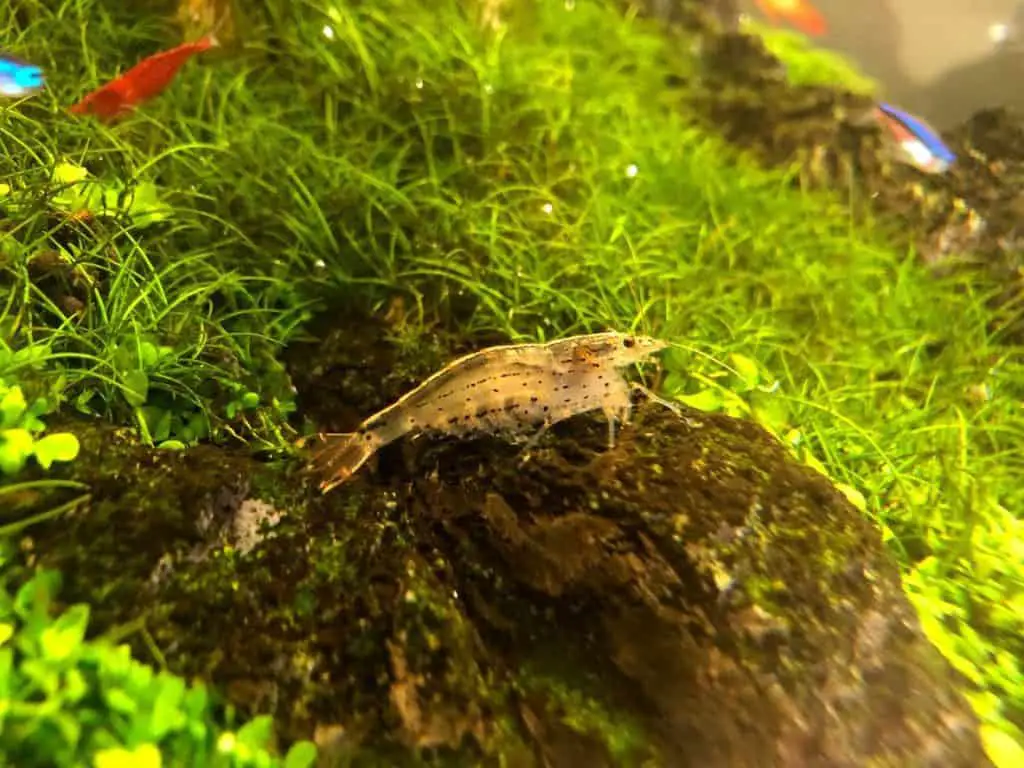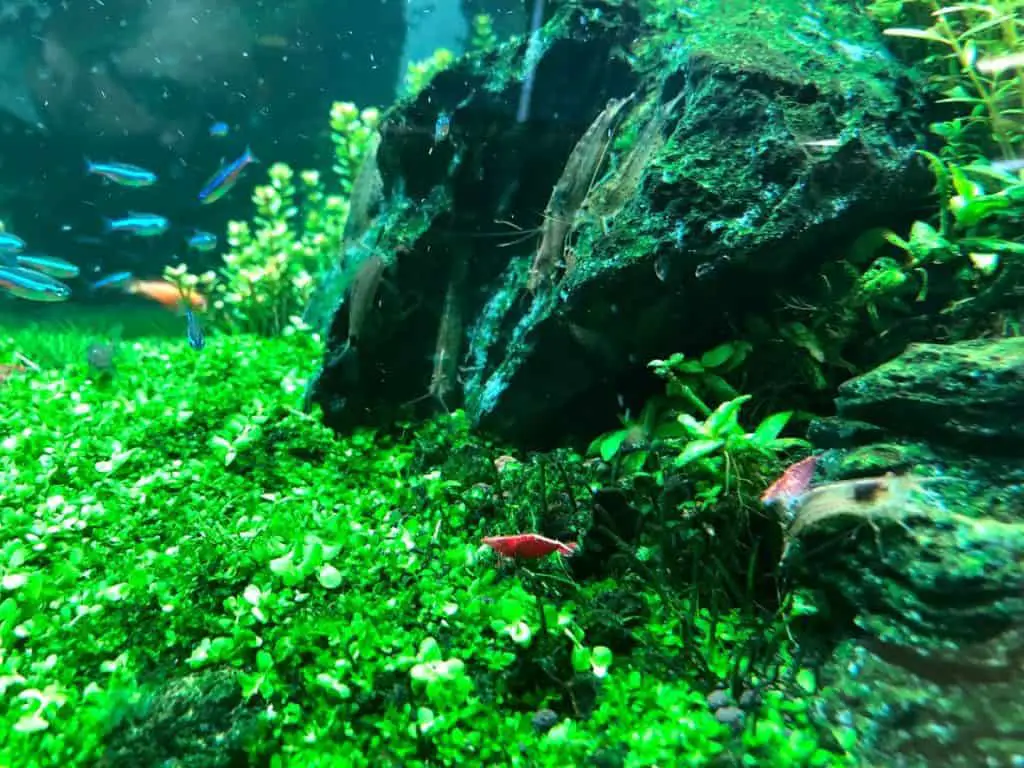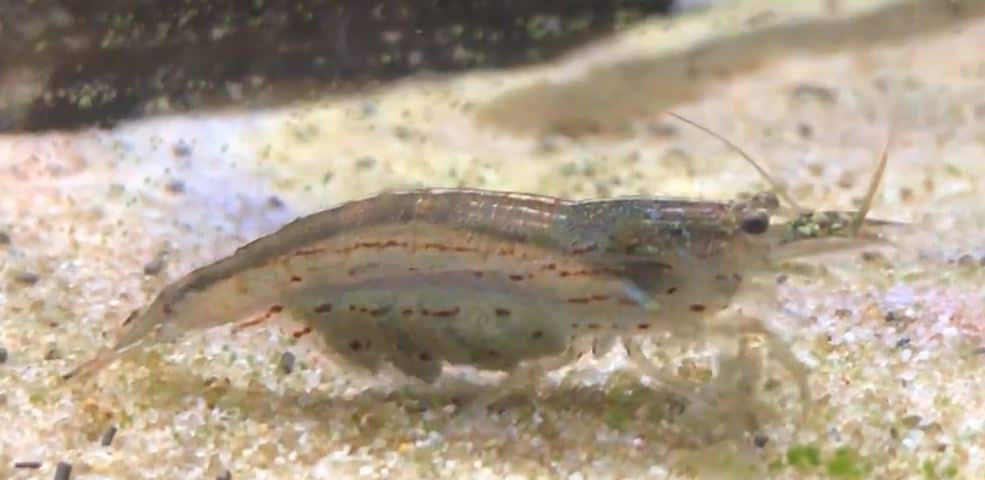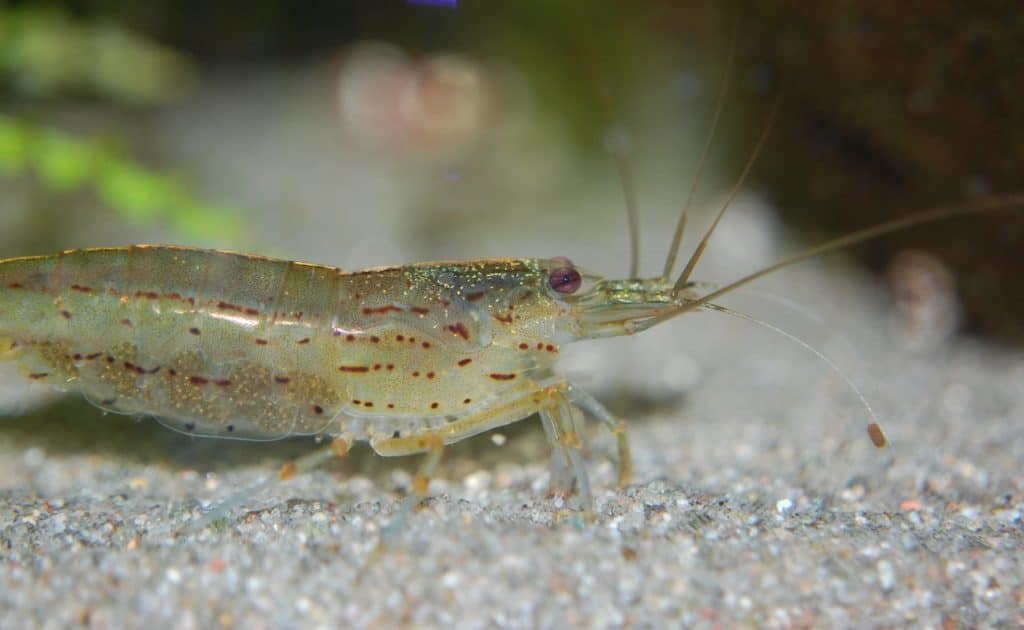Have you ever thought about adding Amano shrimp to your aquarium? You’re in the right place! This guide gives you all the essential information to care for these fascinating creatures.
You’ll learn about setting up the perfect tank, deciding on tank mates, understanding their diet, and much more.
So, let’s start – your journey to becoming an expert on Amano shrimp care starts here!
Key Takeaways
- Design the tank with the specific needs of Amano shrimp, including hiding places and a diet of algae, detritus, and live plants.
- Choose compatible tank mates, such as cherry and ghost shrimp, to maintain a healthy and balanced shrimp tank.
- Monitor the tank temperature and provide a balanced diet to promote the lifespan and health of Amano shrimp.
- Carefully maintain the tank, provide ample hiding spots, and feed a diverse diet to support the well-being of Amano shrimp and their breeding process.
Creating the Ideal Amano Shrimp Tank
Starting with the right environment, you’ll need to design your amano shrimp tank carefully to meet the specific needs of Amano shrimp. Amano shrimp care begins with creating the ideal Amano shrimp tank. The water conditions should be pristine, with water parameters kept in check. The temperature range for Amano shrimp is 22 to 28°C.
Amano shrimp diet is another crucial aspect. They’re omnivores, so a diet of algae, detritus, and live plants will keep them healthy. Shrimp tank mates should be non-aggressive fish. Many aquarists recommend small tetras or rasboras as ideal amano shrimp tank mates. Be sure to provide plenty of hiding places for your shrimp.
Proper care will ensure your Amano shrimp thrive.
Size Matters: Understanding Amano Shrimp Size
Amano shrimp typically grow to a size of around 1.5 to 2 inches. Distinguishing between male and female Amano shrimp is possible by observing their size, with females being slightly larger. Understanding the size dynamics is essential for proper tank management and ensuring the well-being of the shrimp.
Amano Shrimp and Tank Maintenance
Regular tank maintenance is vital for the health of Amano shrimp. Keeping the tank clean, removing uneaten food, and addressing water quality issues are essential. Being diligent in tank maintenance helps prevent common issues such as bacterial infections and ensures a thriving aquatic environment.

Exploring Amano Shrimp Behavior
Amano shrimp are known for their peaceful nature, making them suitable for community aquariums. Observing their behaviors, such as grazing on algae and interacting with tank mates, adds a delightful aspect to aquarium keeping. Their intriguing behaviors make them a popular choice among aquarists.
Amano Shrimp Tank Mates
Choosing the right companionship for your Amano shrimp is essential to their care regime. Amano shrimp are peaceful creatures that do well with certain types of shrimp, including cherry and ghost shrimp. These shrimp species share similar temperaments, making them ideal tank mates.
The compatibility of these dwarf shrimp species helps to maintain a healthy and balanced shrimp tank. Before adding Amano shrimp, ensuring the current inhabitants won’t pose a threat is crucial. Remember, the goal is to keep Amano shrimp safe and stress-free.

Amano Shrimp Lifespan
The lifespan of your Amano shrimp is a crucial aspect you’ll need to understand to provide optimal care. Essential information about Amano shrimp includes their lifespan typically spans 2-3 years in captivity. Here’s what you can do to maximize their longevity:
- Keep your tank within the 70-80 degrees Fahrenheit temperature range. Amano shrimp require specific conditions to thrive.
- Feed your shrimp a balanced diet. This promotes healthy growth and molting.
- Regularly monitor Amano shrimp size as an indicator of health.
- Be attentive to Amano shrimp molting. It’s a natural process but can be stressful.
Amano Shrimp Care
Now that you’re keyed into their lifespan let’s delve into the specifics of Amano shrimp care. These freshwater shrimp require meticulous maintenance to thrive. When introducing Amano shrimp to your tank, ensure they’ve ample hiding spots. Remember, male and female Amano shrimp can cohabit peacefully, making them perfect for community tanks.
Amano shrimp are omnivorous, so a diverse food source is essential. They’ll feed on algae but also appreciate vegetables and commercial shrimp food.
You’ll need male and female Amano shrimp to breed Amano shrimp. But note that Amano shrimp breeding is complex as the larvae need brackish water to survive. So, it’s crucial to research this thoroughly to keep your shrimp population growing.
Amano Shrimp Diet
Understanding your Amano shrimp’s dietary needs is fundamental to their well-being and longevity. Amano shrimp are omnivores, and their diet is primarily algae-based. They love to eat algae, but they also need additional nourishment.
- Shrimp pellets: Amano shrimp also enjoy shrimp pellets, which provide proteins and essential nutrients.
- Algae wafers: These are a favourite. Amano shrimp eat algae wafers with gusto, as they’re packed with the nutrients they need.
- Food removal: Uneaten food should be removed from the tank, as Amano shrimp can be sensitive to water quality.
- Feeding frequency: Feed them twice a week for Amano shrimp optimal health.
Breeding Amano Shrimp
Breeding Amano shrimp in captivity can be challenging due to the larvae’s need for brackish water during the early stages. Providing the right conditions, including a separate breeding tank with brackish water, increases the chances of successful breeding. Observing their courtship behavior and providing appropriate hiding places for newborn shrimp are vital aspects of the breeding process.

Amano Shrimp Molting
Moving on from breeding, another crucial aspect of Amano shrimp care you’ll need to master is their molting process. Amano shrimp molting is a fascinating process where the shrimp shed their old exoskeleton to grow a new one. Since Amano shrimp can grow up to 2 inches, they’ll molt frequently.
Here are some incredible facts:
- Amano shrimp are quite unique because they can molt every few weeks.
- Amano shrimp are known for their impressive molting abilities.
- Amano shrimp are an excellent choice to observe the molting process.
- Amano shrimp are native to Japan and have a 2-3 years lifespan.
Male and Female Amano Shrimp difference
Sexing Amano shrimp is difficult at a young age, but females are larger and have brown, dashed lines along their bodies. Males are smaller and have dots along their bodies.
| Characteristic | Male Amano Shrimp | Female Amano Shrimp |
|---|---|---|
| Size | Smaller | Larger |
| Color | Less vibrant | More vibrant |
| Abdomen | Narrower | Broader |
Amano Shrimp in Captivity
When keeping these fascinating creatures in captivity, your first task is to provide an environment conducive to their health and breeding. These Yamato shrimp were introduced into the hobby by Takashi Amano. Amano shrimp are one of the more popular choices for aquarium enthusiasts, particularly the Japanese swamp shrimp, a species of freshwater shrimp also known as the Amano shrimp.
Here are a few things to consider when keeping shrimp in a tank:
- Even though shrimp are pretty hardy, they require specific water conditions.
- Amano shrimp don’t eat just any feed, so provide an adequate diet.
- Regularly remove sick or dead shrimp from the tank to maintain cleanliness.
- Shrimp can also serve a functional role, helping to control algae.
Caring for these popular freshwater aquarium shrimp can be rewarding and entertaining, making them a great addition to your underwater world.

A Quick Guide to Amano Shrimp: Summarizing Key Points
- Amano shrimp are freshwater crustaceans known for their algae-eating abilities.
- Create an ideal tank environment with stable water conditions, live plants, and compatible tank mates.
- The typical lifespan of Amano shrimp is two to five years, influenced by factors like water quality and genetics.
- Ensure proper care by maintaining stable water parameters, a balanced diet, and understanding the molting process.
- Breeding Amano shrimp requires a separate breeding tank with brackish water for larvae.
- Amano shrimp grow to a size of 1.5 to 2 inches, with females slightly larger than males.
- Regular tank maintenance is essential for preventing issues and ensuring the well-being of Amano shrimp.
- Amano shrimp exhibit peaceful behaviors and are suitable for community aquariums.
- Adapting Amano shrimp to captivity involves providing a stable environment and suitable tank mates.
Frequently Asked Questions
Conclusion
In conclusion, caring for Amano shrimp may seem complicated, but with the right information, it’s a breeze.
Remember Joe, who started with two shrimp and now has a thriving community? He followed these guidelines, focusing on an ideal tank, a varied diet, and compatible tank mates.
With patience and dedication, you too can experience the joy of keeping Amano shrimp. They’re not just pets; they’re a captivating piece of an underwater world right in your living room.
